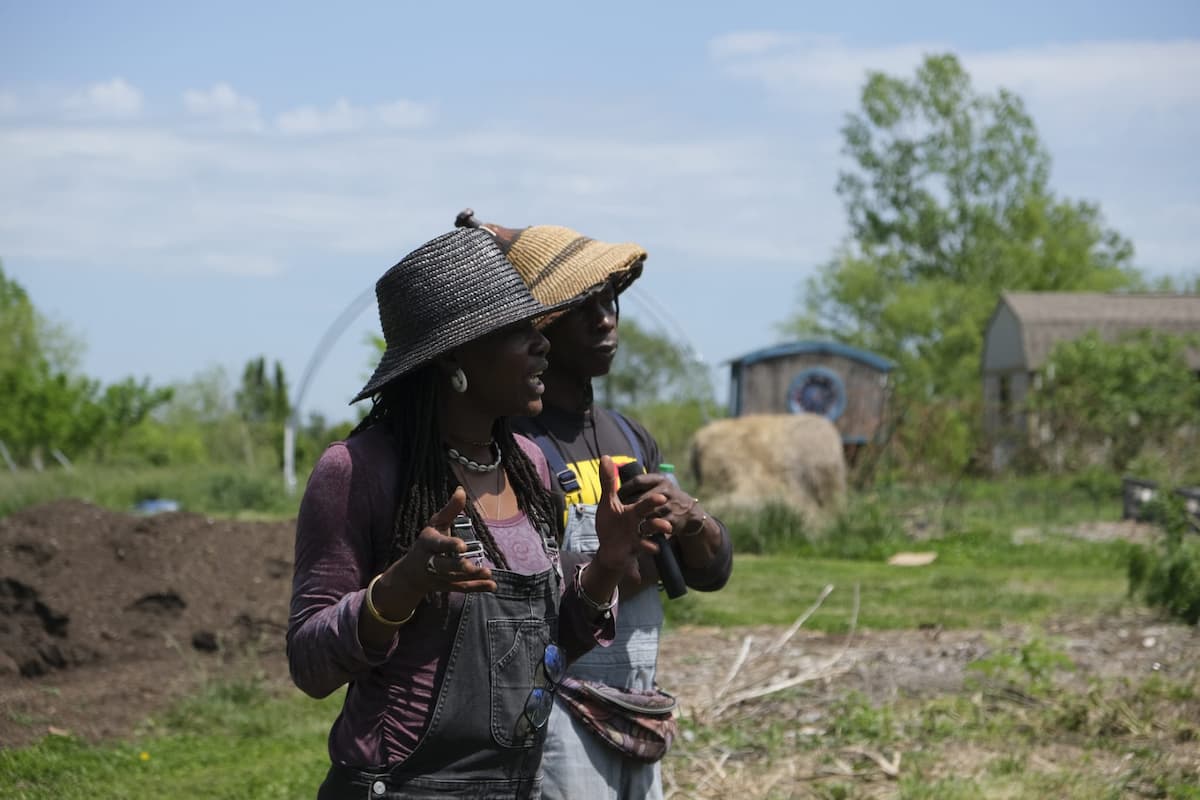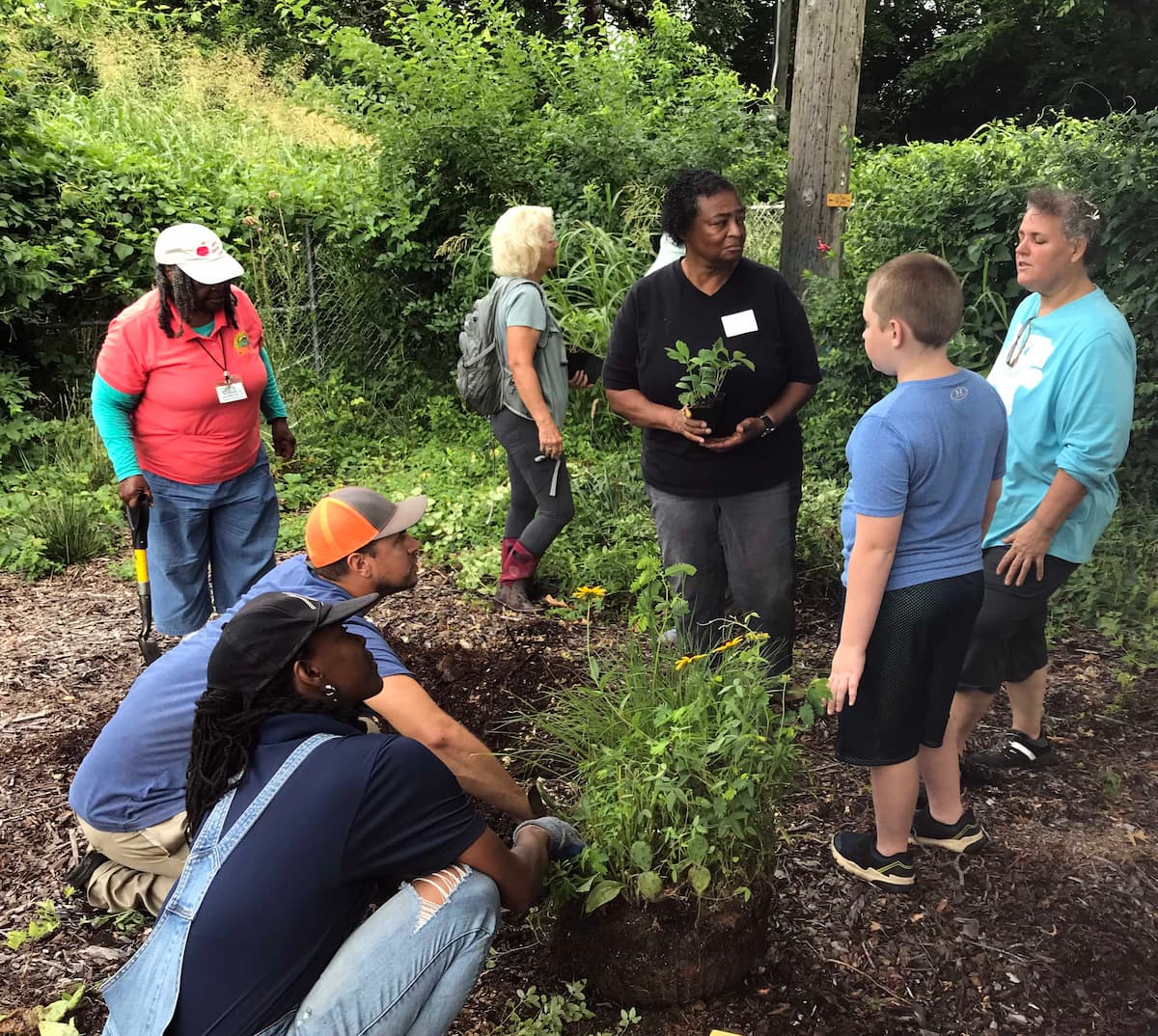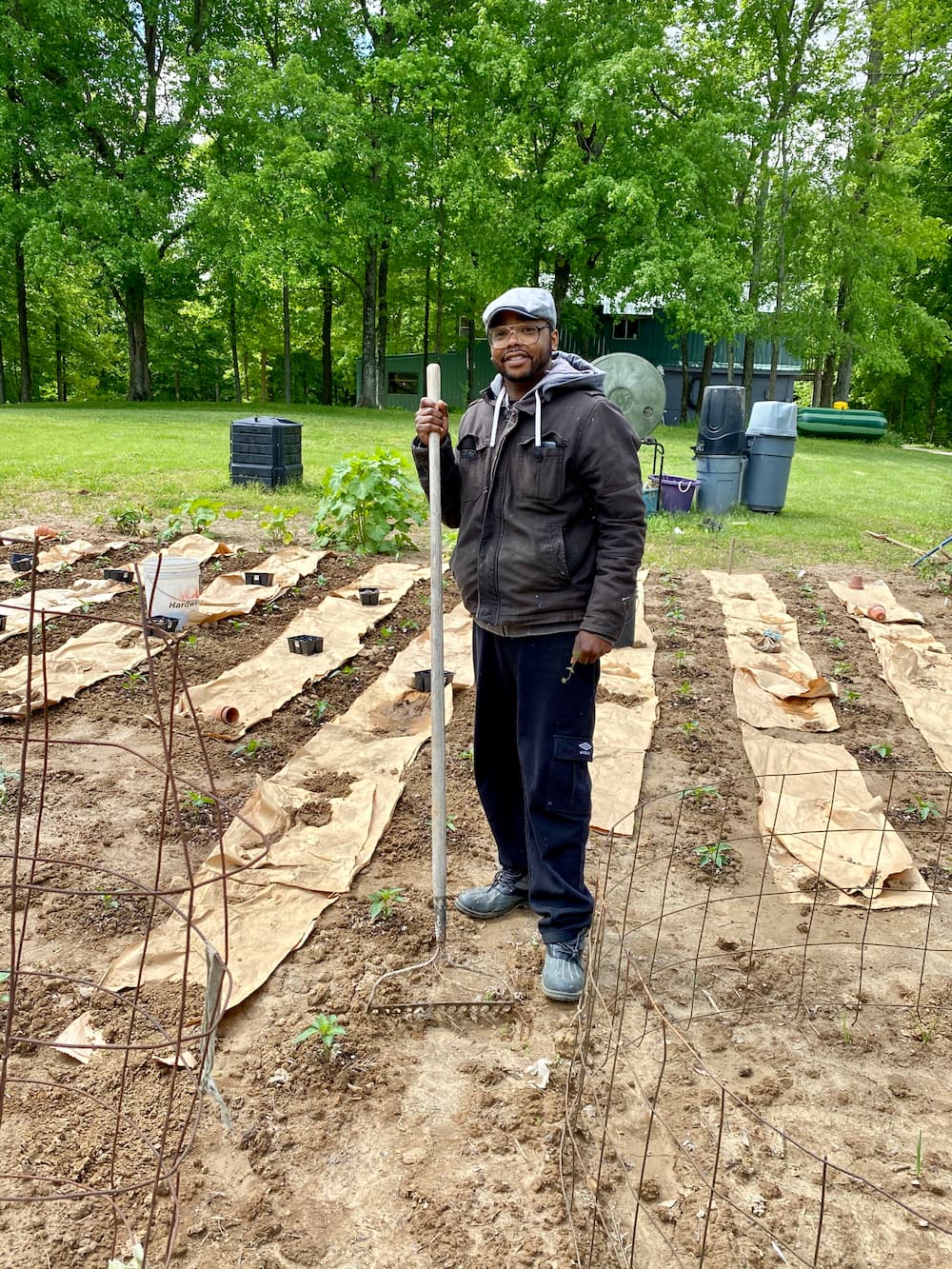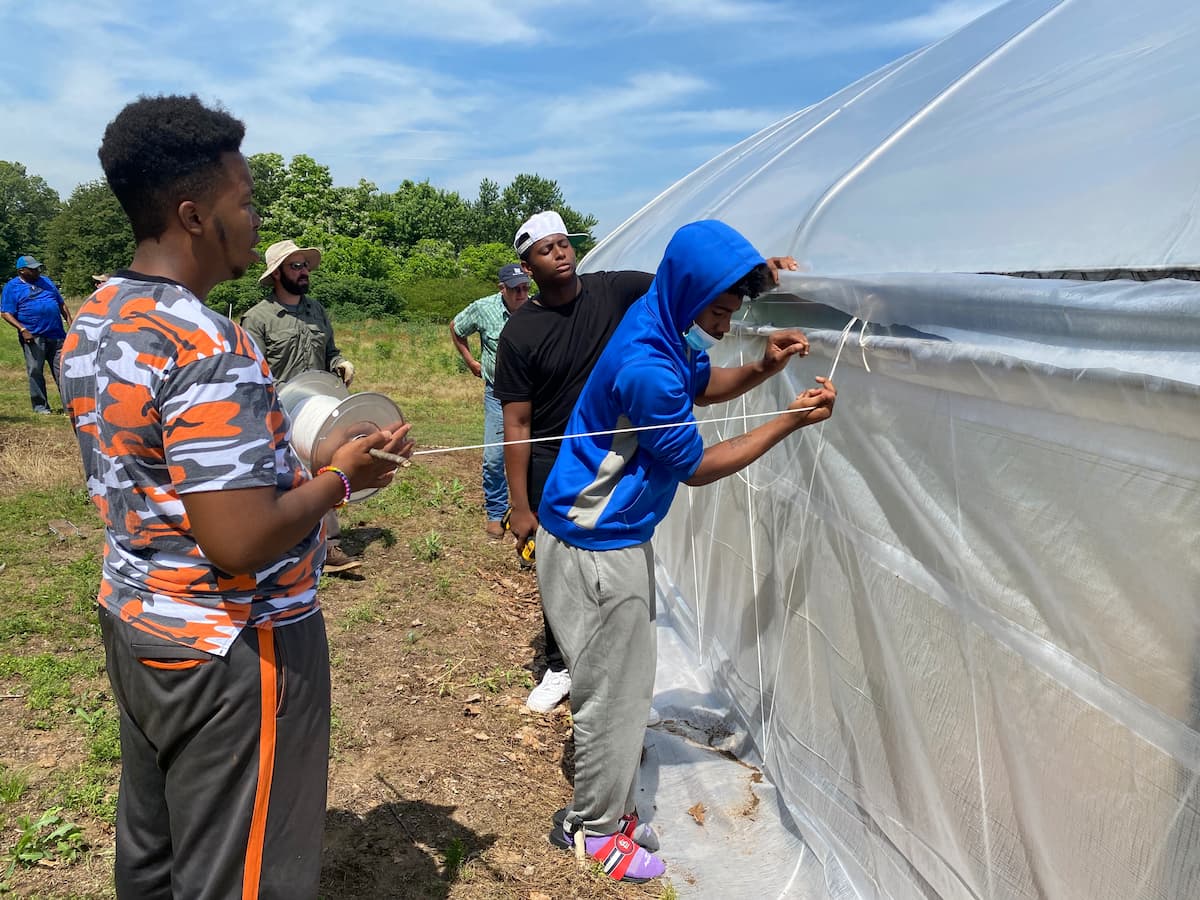Lincoln Supports Growers and Communities with Sustainable Urban Programs
Office of Communications and Marketing
Young Hall
820 Chestnut Street
Jefferson City, MO 65101
 Izula Maximillen and Ryan Tenney on Sankara Farm for Soil Health Field Day 2024 with the Growing Growers Apprenticeship Program.
Izula Maximillen and Ryan Tenney on Sankara Farm for Soil Health Field Day 2024 with the Growing Growers Apprenticeship Program.
No farm is created equal, and there’s no such thing as the perfect spot. Farms differ from state to state, region to region and even town to town. Growers in any location deal with varying soil types, water levels, tree coverage, elevation and a litany of other variables when deciding to establish a farm or garden.
Those challenges and considerations are even more complicated for urban growers, who face unique challenges due to space constraints and proximity to other people.
Fortunately, Lincoln University Cooperative Extension (LUCE) is here to help growers — rural and urban — achieve their farming dreams and, most importantly, become sustainable.
Sustainable farming, and specifically sustainable urban farming, doesn’t have a strict definition. It means different things to different growers, and even different LUCE specialists.
To Julia Thompson, a farm outreach worker with LUCE’s Innovative Small Farmers’ Outreach Program (ISFOP), sustainable urban farming means communities using what they can to achieve their farm and garden goals and grow more effectively.
For example, that could mean surveying your land to figure out what you do and don’t have so you can better allocate resources. Thompson said growers can and should use whatever is available — grass clippings, tree limbs, weeds, wild plants, etc.
“Sustainability is using all your resources as best as you can,” Thompson said.
She said this mindset is especially important when growers don’t have enough money to purchase equipment and other products for enhancing their farms and gardens.
Dr. Anitha Chitturi looks at sustainability from a different angle. Chitturi is an associate professor at Lincoln University of Missouri (LU) and the state extension specialist for LUCE’s Integrated Pest Management Program (IPM).
She said sustainability is about three things: food, environment and security.
Chitturi explained that this boils down to a balancing act for growers: How can farmers use the least amount of energy and resources to grow enough crops to sustain their communities, make a livable income and avoid damaging the environment?
 Urban Planting Class at Precious Petals with Native Plants as Specialty Crops, led by State Extension Specialist Dr. Nadia Navarrete-Tindall.
Urban Planting Class at Precious Petals with Native Plants as Specialty Crops, led by State Extension Specialist Dr. Nadia Navarrete-Tindall.
It’s no simple task, but producers don’t have to do it alone. Like other LUCE specialists, Chitturi works with small and underserved farmers to implement sustainable practices and achieve stability. Through training, workshops and farm visits, IPM helps farmers determine how to manage pests without relying on synthetic chemicals, considering long-term environmental impacts and revenue goals.
“IPM fits into the foundation of sustainability," Chitturi said. "You have to manage everything about crops, from soil to harvest and even post-harvest. Even planting the seeds requires thought. It requires a holistic approach.”
“We want reduced inputs balanced with environmental care,” she added.
Balance is the core of LU Associate Professor and State Horticulture Specialist Dr. Touria Eaton’s definition of sustainable urban farming as well.
Eaton said urban doesn’t just mean being in or around a city; it also means local, where “people use available space to grow food for their community.”
She said doing so sustainably requires three considerations: social, economical and environmental.
“Customers need affordable, locally grown food,” Eaton said. “Farmers should be able to live on revenue from their crops and farming shouldn’t damage the soil, water or air.”
For Farm Outreach Worker Izula Maximillen, community is the heart of sustainable urban farming.
They said sustainable urban programs should nourish holistic community systems addressing food security, environmental health and social equity simultaneously.
In their role as an outreach worker, as well as a community herbalist and birth worker, Maximillen said they’ve seen how urban agriculture can serve as a foundation for broader wellness initiatives.
“To me, sustainability in urban settings means creating programs that don’t just grow food but grow community resilience,” Maximillen said. “It’s about connecting people not just to land and food production, but to each other and to traditional knowledge systems of being in good relationships with soil and water.”
Maximillen said sustainable urban programs should be culturally responsive, economically viable for participants and designed to strengthen community bonds while addressing the environmental challenges unique to urban spaces.
Of those unique challenges, Maximillen, Eaton, Chitturi and Thompson all agree — space is the biggest.
Whereas rural farmers often have acres — sometimes tens and even hundreds — to cultivate crops, urban growers are typically limited.
 Malcolm McCrae at the St. James AME Community Garden in Cape Girardeau County.
Malcolm McCrae at the St. James AME Community Garden in Cape Girardeau County.
“You have to work with what you have. Some people may just have a backyard; some people might have a patio,” Thompson said. “A lot of people I’m meeting only have a windowsill.”
Every grower’s space is different, and there are exceptions to this trend. There are urban farms located on the outskirts of cities (peri-urban farms) or those fortunate enough to have larger tracts of land, allowing for larger operations.
However, even larger urban farms face the challenge of space constraints.
“The main distinction isn’t just proximity to the city, but the integration with urban infrastructure and communities,” Maximillen said. “Urban farms often serve multiple functions — they’re food production sites, but also community gathering spaces, educational centers and examples of environmental stewardship.”
Other significant difficulties include soil health, access to water and proximity to people.
Sustainable practices are the solution to these challenges.
“Sustainability is absolutely critical in urban growing because urban environments present unique challenges and opportunities that rural settings don’t have,” Maximillen said. “Urban sustainability means working with these constraints creatively.”
That’s where LUCE’s specialists and resources come into play. To circumvent space constraints, Eaton said LUCE might advise growers to implement vertical space, like rooftops, or protected agriculture, such as greenhouses and high tunnels.
Urban farms can also utilize indoor mushroom farms, aquaponics setups and even livestock operations — all methods LUCE educates producers on.
Another example is the issue of pesticide application in an urban setting. According to Eaton, pesticide application can have a worse impact in urban areas than in rural settings due to the large number of nearby people.
The problem goes two ways: growers run the risk of affecting others with chemical treatments, and at the same time, are at risk of their crops being contaminated by other sources in the city.
Instead of using potentially harmful synthetic pesticides, Chitturi can recommend a natural, research-backed alternative for growers to manage their pest problem.
By using a botanical-extract-based pesticide, for example, growers can eliminate or prevent pest infestation without affecting beneficial wildlife or the people living nearby.
IPM's recommendations go beyond which natural pest management solution to use, however. One of Chitturi’s biggest goals is to enhance growers’ understanding of pest management, allowing producers to independently evaluate situations and choose the best path forward.
Through this endeavor, Chitturi hopes to change the way growers think about pest management, reducing reliance on synthetic pesticides and potentially lowering the use of pesticides overall.
“Pesticides lead to resistance issues,” Chitturi said. “Eventually, nothing works, making growing unsustainable.”
Eaton also discussed how rural producers rotate their crops to retain soil health and help with pests. In an urban farm or garden with limited space, there’s often little room to rotate, as many growers might only have one plot.
Eaton said some urban growers might tackle this issue by changing their crop yearly, but this method isn’t always economical. LUCE’s sustainable urban programs introduce alternatives for situations like these. In this case, a specialist might talk to the grower about soil remediation techniques or utilizing succession planting.
“Sustainability is not a luxury, it’s a must,” Eaton said. “There are difficulties, but there are also solutions.”

Youth working on an NRCS EQUIP high tunnel in Sott County.
In their work with Jackson County producers, Maximillen said they’ve seen how urban growers must navigate limited space, soil contamination concerns, water access issues and zoning restrictions. Growers utilize vertical growing, build soil health in contaminated areas and create closed-loop systems to turn urban waste into agricultural inputs, Maximillen explained.
Maximillen engages in several programs embodying sustainable urban principles and helping urban producers tackle these issues.
As an ISFOP outreach worker, Maximillen conducts one-on-one consultations and group workshops with urban and peri-urban farmers, connecting them to evidence-based resources and United States Department of Agriculture programs.
Just as important as establishing research-backed, sustainable practices is connecting with those in the position to implement them.
As a farmer herself, Thompson said she loves connecting with other growers.
“It comes easily to me. I meet farmers from all walks of life, and I genuinely love it,” Thompson said. “I don’t see my position as a job, but as an asset.”
Thompson said she attends farmers markets and lives in the community she serves, making it simple to connect with growers and share LUCE resources.
Similarly, Chitturi stressed the importance of building trust and integrating LUCE programs and specialists in communities.
“We don’t just provide technical information, we want to benefit the community,” Chitturi said. “We have to ask, ‘How can the farmer save money and help the community?’”
Despite the challenges surrounding urban farms and gardens, the benefits to the communities they serve are what truly set them apart from many traditional, rural farms.
Many community gardens are located at schools, giving students the opportunity to learn about agriculture and food production from a young age.
Other growers supply local restaurants, providing revenue for the grower, healthy food for customers and a selling point for the restaurant owners.
Sustainable urban farms are often located in underserved communities and food deserts. By producing safe, healthy crops, they support the neighborhoods they serve and become more than just a farm. They become neighborhood assets, acting not only as food sources but as community centers and educational venues.
LUCE and its specialists, like Maximillen, Eaton, Chitturi and Thompson, utilize workshops, farm visits and field days to share research-based programming with urban growers to establish sustainable practices and best serve those communities.
“It’s about ensuring that urban farming initiatives serve the communities where they’re located, particularly undeserved and low-income populations who often face the greatest food insecurity and comorbidities yet have the least access to fresh, healthy produce,” Maximillen said. “Urban farms have unique opportunities to create symbiotic relationships that benefit both the farm and the broader urban ecosystem.”
